The Fabulous Fifties




 The influences of Elvis have ranged from his largest, black music to country singers and vocalists like Dean Martin and Mario Lanza. Though he did not invent rock and roll, Elvis made it famous and appealed to teenage girls who went hysterical over him, while adults looked on in shock. In 1956 Ed Sullivan allowed Elvis to appear on his show but cameramen were told to only shoot from the waist up or else the censors would cause an argument. This was, of course, because no one had a pelvis like Elvis! With a hip swing and a finger point, Presley had the ability to cause shrieks from his female audience which he privately found amusing. Though he is known as the "King of Rock 'n' Roll", many other respectable singers followed the phenomenon of Elvis.
The influences of Elvis have ranged from his largest, black music to country singers and vocalists like Dean Martin and Mario Lanza. Though he did not invent rock and roll, Elvis made it famous and appealed to teenage girls who went hysterical over him, while adults looked on in shock. In 1956 Ed Sullivan allowed Elvis to appear on his show but cameramen were told to only shoot from the waist up or else the censors would cause an argument. This was, of course, because no one had a pelvis like Elvis! With a hip swing and a finger point, Presley had the ability to cause shrieks from his female audience which he privately found amusing. Though he is known as the "King of Rock 'n' Roll", many other respectable singers followed the phenomenon of Elvis.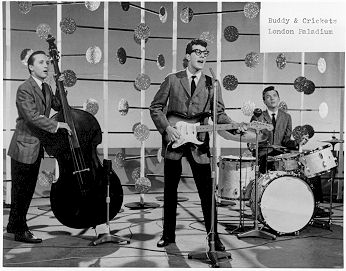 On February 3 of 1959, tragedy struck the music world, which would be called "The Day the Music Died", when a plane crashed killed the Big Bopper, Buddy Holly and Richie Valens-all very inspiring musicians. People began to say that rock and roll was dead as three of the most popular musicians were dead, Jerry Lee Lewis had been banned, Chuck Berry had gone to prison and Elvis had joined the Army. By the end of the decade the average age of the record buyer had been lowered, a new style of rock and pop had been introduced that would be the roots of many future bands.
On February 3 of 1959, tragedy struck the music world, which would be called "The Day the Music Died", when a plane crashed killed the Big Bopper, Buddy Holly and Richie Valens-all very inspiring musicians. People began to say that rock and roll was dead as three of the most popular musicians were dead, Jerry Lee Lewis had been banned, Chuck Berry had gone to prison and Elvis had joined the Army. By the end of the decade the average age of the record buyer had been lowered, a new style of rock and pop had been introduced that would be the roots of many future bands.
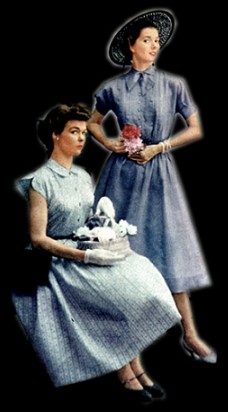 In the Fifties every woman looked to Paris, more particularly designer Christian Dior as the guide for haute couture. After having introduced the 'New Look' a few years earlier, Dior, in 1950 changed the A-line style just enough to make it a more oblique style. A new young designer, Yves Saint Laurent, also introduced a similar style. The stylish man of 1950 wore a Mayfair Edwardian style of dress which consisted of a curly bowler, narrow trousers, single-breasted coats with velvet collars and a rolled-up umbrella. Elegance was back.
In the Fifties every woman looked to Paris, more particularly designer Christian Dior as the guide for haute couture. After having introduced the 'New Look' a few years earlier, Dior, in 1950 changed the A-line style just enough to make it a more oblique style. A new young designer, Yves Saint Laurent, also introduced a similar style. The stylish man of 1950 wore a Mayfair Edwardian style of dress which consisted of a curly bowler, narrow trousers, single-breasted coats with velvet collars and a rolled-up umbrella. Elegance was back.
In the Fifties, traditional styles which mimicked photographs became much more sophisticated and cosmopolitan in design. Artists such as Jon Whitcomb and Austin Briggs were the leaders of their time in the new commercial art approach.
On the other side of the art world more avant-garde artists were creating masterpieces. Jackson Pollack's critics considered him one of the greatest artists of the time while beat artists greatly admired his work. His nickname was "Jack the Dribbler" because of his technique of painting his canvasses with a stick or directly from the can. His work belonged to a group of artists called "action artists" whose work was spontaneous. Pollack would die in 1956 of an automobile accident and his paintings years later would sell for hundreds of thousands of dollars.
Along with the avant-garde artists was a new culture known as the Beats. 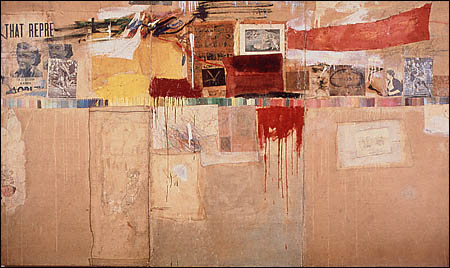 They too had artists who painted abstract, sometimes dark, sometimes realists portraits and photography. Some of the beat artists were Wallace Berman, Jay DeFeo, Franz Kline, Claes Oldenburg, Robert Rauschenberg, Larry Rivers, Michael McClure and Robert LaVigne to name only a few. Some very interesting pieces of the beat art would consist of different kinds of mediums employed on the canvas. Fabric, glass, paint, news headlines and commercial product labels.The new commercial art would carry on to the next decade when artists like Andy Warhol took art to a different level.
They too had artists who painted abstract, sometimes dark, sometimes realists portraits and photography. Some of the beat artists were Wallace Berman, Jay DeFeo, Franz Kline, Claes Oldenburg, Robert Rauschenberg, Larry Rivers, Michael McClure and Robert LaVigne to name only a few. Some very interesting pieces of the beat art would consist of different kinds of mediums employed on the canvas. Fabric, glass, paint, news headlines and commercial product labels.The new commercial art would carry on to the next decade when artists like Andy Warhol took art to a different level.
The following have some art of the fifties and fifties advertisements:

Much to movie makers dismay, the fifties saw a continuing upward trend of the popularity of the television. The T.V. has been called everything from the "boob tube", the "idiot box" to "the light that failed", yet it is the basis of pop culture. It shows the news, it advertises, it informs of what is happening at the time and, above all, it entertains millions of people everyday. In fact, by 1959, an average American household was watching about 6 hours of television a day and there were many shows to keep their eyes glued to the set.
Perhaps one of the greatest ideas of the Fifties is the sitcom, and none did it better than "I Love Lucy". The show had the misadventures of redheaded Lucille Ball and her Cuban husband Desi Arnaz.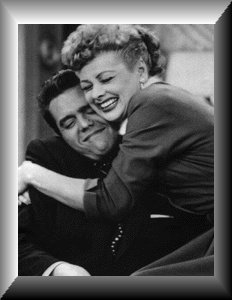 The show was so popular that in January of 1953 more Americans watched "I Love Lucy" on Monday nights than President Eisenhower's inauguration. The audience of "I Love Lucy" would surpass 50 million and the show would go on to be the inspiration of future sitcoms.
The show was so popular that in January of 1953 more Americans watched "I Love Lucy" on Monday nights than President Eisenhower's inauguration. The audience of "I Love Lucy" would surpass 50 million and the show would go on to be the inspiration of future sitcoms.
Other sitcoms of the Fifties that left their marks were shows such as "The Honeymooners", "Leave it to Beaver", "Father Knows Best", "The Phil Silvers Show", "Ozzie and Harriet" and "The Burns and Allen Show".They were all known as situation comedies and were all the roots of the television explosion.
Along with comedies, action-adventure shows produced with young boys in mind, became extremely popular. Disney produced "Zorro" and "Davy Crockett", and little boys all had to have swords to make the trademark "Z" and fur hats like Davy. Other shows which had gun-slinging heroes were "Maverick", "Cheyenne", "Gunsmoke", "Wagon Train", "Restless Gun" and "The Lone Ranger". In the Fifties a great fascination with the Old West was transformed onto the small screen with great success. Other popular shows of the decade with children were "Lassie", "Rin-Tin-Tin", "Kukla, Fran and Ollie", and "The Mickey Mouse Club".
Quiz shows were a very popular half hour with viewers, that is before scandal took hold in the later-fifties. But before that silly, inconsequential shows such as "What's My Line?", "Twenty-One" and "The $64, 000 Question" kept viewers laughing, grimacing and having fun along with the often-befuddled contestants.
The Golden Age of Television would not have been complete with its resident variety acts. Milton Berle, Sid Caesar, Red Skeleton and numerous amateur hours filled black and white screens. Talk show legends such as Johnny Carson, Steve Allen and Jack Paar all had their own late night shows. Ed Sullivan began his variety show which would continue for more than a decade.
"The Twilight Zone", "Alfred Hitchcock Presents", "Perry Mason", "Peter Gunn" and "The Untouchables" were geared towards the more older, mature viewer. All are now seen as classic television and remakes of a few of the shows have been made. Did Perry Mason ever lose a case?!
Classic Boob-Tube:

Movie stars of the Fifties achieved even greater fame with the multitudes of fan magazines
that were printed each month. Stars like Natalie Wood, Rock Hudson, Marilyn Monroe,
Elizabeth Taylor, Tony Curtis, Grace Kelly, Debbie Reynolds, Kim Novak and Sophia
Loren graced covers each month. The Fifties are at times looked at as the last great
Hollywood era, and out of this era came many famous and now regarded as classic
movies.
Perhaps the greatest Hollywood legend of the Fifties was James Dean.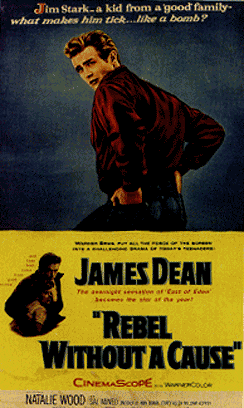 His movie career lasted for just two years until he was killed in an
automobile accident on a way to a race on September 30, 1955. In his life he only saw the
release of one movie and that was "East of Eden". His most famous movie may be "Rebel
Without a Cause" and was seen as a classic teenage drive-in movie. It had a troubled Jim
Stark, the new kid in town, trying to fit in while keeping a tough exterior and also saw the
adult debut of Natalie Wood playing a confused girl. The movie became famous for Dean's
dark jeans, white T-shirt and red jacket. Following Rebel, Dean made his final movie with
Elizabeth Taylor and Rock Hudson-"Giant"-a sweeping epic about a family over a half a
century who lives in Texas.
His movie career lasted for just two years until he was killed in an
automobile accident on a way to a race on September 30, 1955. In his life he only saw the
release of one movie and that was "East of Eden". His most famous movie may be "Rebel
Without a Cause" and was seen as a classic teenage drive-in movie. It had a troubled Jim
Stark, the new kid in town, trying to fit in while keeping a tough exterior and also saw the
adult debut of Natalie Wood playing a confused girl. The movie became famous for Dean's
dark jeans, white T-shirt and red jacket. Following Rebel, Dean made his final movie with
Elizabeth Taylor and Rock Hudson-"Giant"-a sweeping epic about a family over a half a
century who lives in Texas.
James Dean said that one of his idols was Marlon Brando and that he repeatedly watched
Brando's "The Wild One". In the movie Brando was the leader of a biker gang who
muttered the famous line "Whaddya got?" when asked what he was rebelling against.
Previously Brando had starred as Stanley Kowalski in Tennessee William's "A Streetcar
Named Desire" alongside a fragile Vivian Leigh. Another actor making his debut, Paul
Newman. would also star in a William's story, this time "Cat on a Hot Tin Roof" with
Elizabeth Taylor.
Epics are part of Hollywood tradition and some of the biggest came in the Fifties. Charlton
Heston starred in two of the most famous-"The Ten Commandments" and "Ben-Hur".
Also noticeable was "War and Peace". As with epics, and just as popular, were musicals.
The big stars of the day, Gene Kelley, Frank Sinatra, Fred Astaire, Bing Crosby and
Rosemary Clooney, just ot name a few, all made movies. Probably the most popular were
Kelley's "Singing in the Rain" and "An American in Paris" though Clooney and Crosby
also starred in "White Chirstmas", which though is incredibly fluffy, has some great songs
in it! Another actor new to the musical was teenage hearthrob Elvis Presley who rocked in
Jailhouse Rock before entering the army, yet he would continue his movie career the
following decade.
Psychological thrillers were popular and nobody did them better than Alfred Hitchock, and
his favourite leading lady, Grace Kelly. "Rear Window", "To Catch a Thief" and
"Vertigo" were some great thirllers.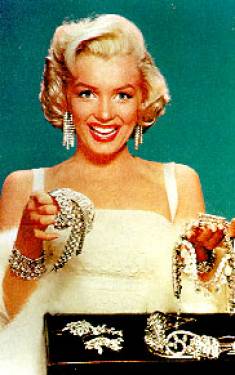 The most
famous actress of the Fifties was Marilyn Monroe and her movie roles were almost always
comedic. "Some Like it Hot" had her starring with a cross-dressed Jack Lemmon and Tony
Curtis and before that classic she starred in "Gentleman Prefer Blondes", "The Seven Year
Itch", "How to Marry a Millionaire" and "Monkey Business". She longed for more
dramatic roles but was famous for playing a blonde sexpot and nobody did it better.
The most
famous actress of the Fifties was Marilyn Monroe and her movie roles were almost always
comedic. "Some Like it Hot" had her starring with a cross-dressed Jack Lemmon and Tony
Curtis and before that classic she starred in "Gentleman Prefer Blondes", "The Seven Year
Itch", "How to Marry a Millionaire" and "Monkey Business". She longed for more
dramatic roles but was famous for playing a blonde sexpot and nobody did it better.
Besides the blockbusters other noticeable and famous movies were created in the Fiftes.
Gregory Peck starred in the movie adaption of " Man in the Grey Flannel Suit" while
Anthony Quinn starred in the Italian "La Strada" which took place in a circus and had a
young girl following around her abusive, wrestler husband. "An Affair to Remember" was
the tearjerker of the decade and undoubtedly was the inspiration for many soap operas!
"Gidget" was the girl midget and had Sandra Dee playing a tomboy who wanted to catch
Moondoggy's eyes. It was of the surfer genre and made for teenagers, along with other sci-
fi classics such as "The Blob" and low-budget productions by Ed Wood! Bridget Bardot
starred in "And God Created Woman" which was viewed as obscene, lewd and a raucious
sex movie. Bardot naturally became the object of many young men! Along with all of these
movies came the popular westerns, court-room dramas and more comedies that made the
decade so memorable.
Just a few of the many Fifites movies and actor/actresses links:

During the time of the Cold War a new generation of people with new values and ideas surfaced. They were known as the Beats and they lived what was known as the Beat Culture. Stereotypically, and due to some terrible films, the public thought of Beats as tempermental people who dressed all in black and had a propensity for violence, poetry and the elimination of morals. In fact the Beats could now be considered ahead of their time with their experimentations within mediums and their acceptance of homosexuality and interracial relationsips, views which caused the Beats censorship and sensation within the public. With all of this distaste for the Beats it would be difficult to have imagined that decades later the literature, art and films made by the Beats would be some of the most sought after and respected work in American history.
Probably the two most famous writers of the Beat era were Jack Kerouac and Allen Ginsberg. Kerouac (who invented the term "Beats") wrote the famous "On the Road", a story about a Sal Paradise, travelling back and forth across America with an assortment of different friends on the fringes of society in the late '40's and early '50's. The book made Kerouac the ultimate Beat, with his passages in the book of being a "disillusioned white man", refusing to become a straight for as long as he can and embracing the whole Beat ideal of mysticsm, acceptance and difference. Many other writers of the Beat period such as William Burroughs and Diane DiPrima also echoed Kerouac's thoughts.
Kerouac (who invented the term "Beats") wrote the famous "On the Road", a story about a Sal Paradise, travelling back and forth across America with an assortment of different friends on the fringes of society in the late '40's and early '50's. The book made Kerouac the ultimate Beat, with his passages in the book of being a "disillusioned white man", refusing to become a straight for as long as he can and embracing the whole Beat ideal of mysticsm, acceptance and difference. Many other writers of the Beat period such as William Burroughs and Diane DiPrima also echoed Kerouac's thoughts.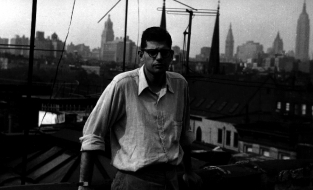 Allen Ginsberg was the son of a poet and schoolteacher and was set to become a market research consultant and book reviewer, a very middle-class inspiration. He met Jack Kerouac in Columbia University and a few years later wrote "Howl", which turned him into the quintessential Beat poet.
Allen Ginsberg was the son of a poet and schoolteacher and was set to become a market research consultant and book reviewer, a very middle-class inspiration. He met Jack Kerouac in Columbia University and a few years later wrote "Howl", which turned him into the quintessential Beat poet.
The uniqueness of the Beat culuture was that, in a time of segregation and racism, a strong Black beat culture was creating its own culture. The music of the times had jazz roots and was called Behop. Charlie Parker and Dizzy Gillespie represented the new generation of jazz music with its birth place in New Orleans. Along with music was a huge collection of Black art; some of the most noticeable artists were Aaron Douglas, Elizabeth Catlett, Jacob Lawrence and Norman Lewis. Writers of Black literature included Ralph Ellisons famour "Invisible Man", James Baldwin's "Go Tell It on the Mountain", and Gwendolyn Brooks' "Annie Allen". Other authors, along with the ones mentioned, also made a statemet on the situation of the Negro man in America through fiction. At the time these books were wrote a 14 year old black boy in Mississippi had been brutally murdered for calling a white woman pretty, school in Little Rock, Arkansas were trying to be segregated to the protests of millions of Whites and Martin Luther King Jr. had began his plight for equality among all nations after a Rosa Parks in Mobile, Alabama had refused to sit in the back of a bus. With a combination of the news and a burgeoning black culture the rest of America was beginning to finally take notice and listen to what had been already been said a hundred years before.
When Sloan Wilson wrote "Man in the Grey Flannel Suit" he made an important observation about the state of the faceless American man who went to his 9 to 5 job, had two kids and lived in suburbia. J.D. Salinger wrote "The Catcher in the Rye", a story about a young boy's observations about his world, and Grace Metalious "Peyton Place" caused much controversy with its sex and scandal. So much was happening in the Fifties-baby boomers were growing up, a new population of people had their own ideas and aspects of society that had once been thought taboo were coming to notice. It would be the next decade that would see a climax of the counter-culture having a voice of its own and it would be even later when people would begin to look back at the Fifties with fondness and wish for those days.
Just a few sites on the Beats and underground culture can be found here:

The "Fashion" picture is courtesy of Kris Faria and Andrew Sagatelian
Style-o-rama